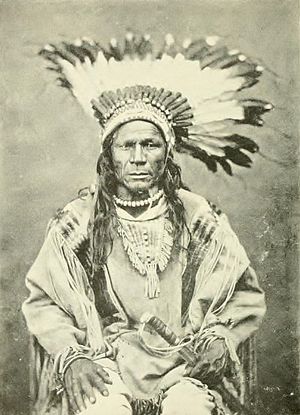Crow Flies High facts for kids

Crow Flies High (in Hidatsa: Beericga Maaguhdaa Neesh) lived from about the 1830s to 1900. He was a brave chief of a group of Hidatsa people who wanted to live their own way. From 1870, he led his group. They were one of the last Native American groups to move onto an Indian reservation in 1894. Today, a North Dakota State Park is named after him.
Contents
Life Before the Reservation
The Smallpox Epidemic
In 1837, a terrible sickness called smallpox hit the Hidatsa people. It caused many deaths. Crow Flies High lost his close family members. He was then raised by other relatives.
After the sickness, the Hidatsa joined with the Mandan tribe. Around 1845, they built a new home. This was the Like-a-Fishhook Village along the Missouri River.
Leaving Like-a-Fishhook Village
By 1870, Crow Flies High had disagreements with other chiefs. He decided to leave the Fort Berthold reservation in North Dakota. This reservation was home to the Hidatsa, Mandan, and Arikara tribes.
Crow Flies High and his followers moved near Fort Buford. This was a military base. They wanted to live freely and follow their own ways. They did not want to follow the old leaders.
A serious disagreement happened in Like-a-Fishhook Village. Crow Flies High and another leader, Bobtail Bull, felt that food from the government was not shared fairly. There were even rumors that Crow Flies High might be harmed. So, he and Bobtail Bull decided to leave.
Many people joined them. Between 140 and 200 Hidatsa and Mandan people left. They came from different families.
Life in New Villages
The Garden Coulee Village
The group settled near the Yellowstone River. Their new home was on the north bank of the Missouri River. It was close to the Fort Buford military base. This spot was good because Fort Buford protected them from attacks by the Sioux tribe. It also offered a place to sell animal furs. The Hidatsa had always been friendly with the U.S. Army.
Their new village had log cabins and earth lodges. They also dug storage pits for food. In 1886, Crow Flies High said they lived by hunting buffalo and deer. They sold the animal hides at Fort Buford. When buffalo became rare, they started planting gardens.
Some people from the village became scouts and hunters for the fort. They earned regular pay. When food was scarce, they sometimes asked for help at the fort. Crow Flies High made sure his people paid for any farm animals they accidentally hunted.
People often moved between Garden Coulee and Like-a-Fishhook Village. The village usually had about 150 people. It was a winter home and a stop for hunting trips. The villagers also received government food when they visited Like-a-Fishhook. Over time, Crow Flies High became the recognized chief of this village.
Moving from Fort Buford
For many years, the Hidatsa and the soldiers at Fort Buford lived peacefully. But things changed in 1883. The Sioux were no longer a threat to the fort. Also, the village grew to 240 people. The fort commander wanted them to leave.
Crow Flies High had refused to move back to the Fort Berthold reservation before. But on September 20, 1884, the commander reported they were finally leaving. Many had lived there for fifteen years. Fort Buford bought their empty log cabins for firewood. The Hidatsa used the money to buy supplies for their journey downstream.
Crow Flies High Village
The villagers started a new home near some valleys. They already had small gardens there. They built about twenty-five cabins close to the Missouri River. This was a few miles above the Little Knife River.
There was also a simple earth lodge used as a "dance hall." This new village was inside the reservation. But it was more than 50 miles from Like-a-Fishhook Village.
In 1886, the Fort Berthold Indian Reservation became smaller. This meant Crow Flies High's village was once again outside the reservation borders. The government wanted children to attend the reservation school. But no children from Crow Flies High's village went.
Crow Flies High lived in the village with his two wives. His son also had his own cabin. The villagers hunted deer and small animals. They also grew crops. They sold firewood to steamboats on the Missouri River.
Once, some ranchers accused the villagers of killing their cattle. Crow Flies High went to the Agency to explain. The Indian Agent believed him. So, the case against the villagers was dropped.
The Last Years of Crow Flies High
In 1894, Crow Flies High stepped down as chief. Soon after, soldiers from Fort Buford and Hidatsa scouts helped his group move. This group included 125 Hidatsa, 23 Mandan, and 1 Arikara person.
Some Hidatsa people felt sad that the soldiers seemed to forget their help as scouts. The group traveled in a long line. They used horses with packs and travois (a type of sled). They also used Red River carts.
The group was given land all over the reservation. But they slowly gathered together in the Shell Creek area.
Crow Flies High passed away in 1900 from pneumonia. The Crow Flies High State Recreation Area in North Dakota is named in his honor.

